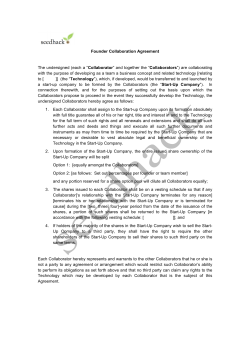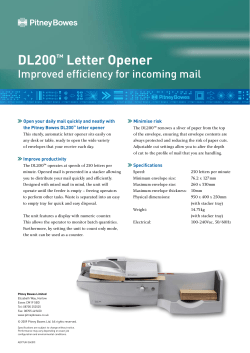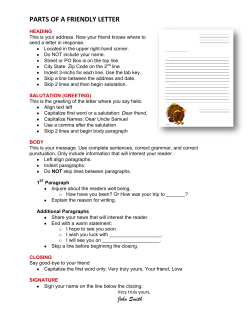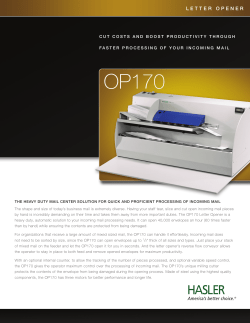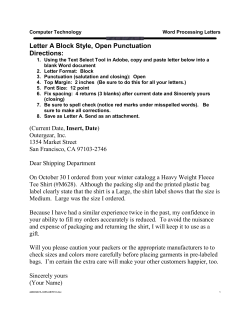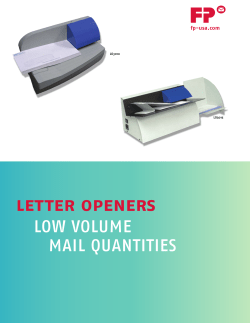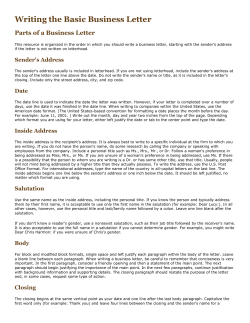
Writing to a Prospective Collaborator Celia M. Elliott
Writing to Collaborators, Celia M. Elliott June 2007 Writing to a Prospective Collaborator Celia M. Elliott Department of Physics University of Illinois cmelliot@uiuc.edu TM Copyright © 2007 The Board of Trustees of the University of Illinois This presentation will tell you how to compose a letter to a prospective collaborator, what information to include, and what tone to use so that the recipient will be more likely to respond positively to your request. 1 Writing to Collaborators, Celia M. Elliott June 2007 Goals for this session Learn the rules for writing a formal letter Learn how to ensure that your email actually gets read Learn how to make a Western scientist want to collaborate with your team 2 Goals: 1) Learn the rules for writing a formal letter 2) Learn how to ensure that your email actually gets read 3) Learn how to make a Western scientist want to collaborate with your team 2 Writing to Collaborators, Celia M. Elliott June 2007 Include all elements of a formal Western business letter Letterhead Subject: Date Inside Address Salutation: Body Closing, Signature Title 3 Elements of a formal Western business letter (see slide): 1) Use letterhead from your institution, if available 2) Date 3) Inside address 4) Subject 5) Salutation/ “greeting” 6) Body 7) Closing/your signature/title 3 Writing to Collaborators, Celia M. Elliott June 2007 If you do not have access to letterhead, make your own Institute of Cell Biophysics Pushchino, Moscow Region 142292 Russia Phone: +7 (0967) 73-05-19 / +7 (095) 25-59-84 Email: admin@mars.ibioc.serpukhov.su 4 Make your own letterhead—be creative in order to be professional. 4 Writing to Collaborators, Celia M. Elliott June 2007 After the date, type the “inside address” Repeats the same information that is on the envelope Arrange in the following order (each bullet is a separate line): [Title] [First name] [Initial] [Family Name] Department or Division Name of the Institution Post Office Box or Street Address City, State Postal Code Country 5 • Inside address is a repeat of what appears on the envelope • Order: 1) [Title] [First name] [Initial] [Family Name] 2) Department or Division 3) Name of the Institution 4) Post Office Box or Street Address 5) City, State Postal Code Country 5 Writing to Collaborators, Celia M. Elliott June 2007 Provide a concise, descriptive subject line after the inside address Restrict to one or two lines Begin with “RE:” or “Subject:” RE: Research Opportunity in High-Energy Astrophysics Subject: Joint Research on Black Hole Physics and Relativistic Astrophysics funded by International Agency 6 Subject line = concise description of your purpose for the letter: 1) 1-2 lines only 2) Begin with “RE:” or “Subject:” 3) PUNCTUATION is important if you want to be professional 4) See examples on slide 6 Writing to Collaborators, Celia M. Elliott June 2007 After the inside address comes the “salutation” “Dear” [Title] [Family Name]: If the person works at a university, address him or her as “Dear Professor” [Family Name]: If the person works at a national lab or a private company, address him or her as “Dear Dr.” [Family Name]: Follow the salutation with a colon (:) 7 Salutation = Greeting 1) “Dear [title] [Family name] (see slide) 2) If person is at natn’l lab or private company, use “Dr.” 3) Follow salutation w/ a colon (not an exclamation mark) 7 Writing to Collaborators, Celia M. Elliott June 2007 The body of the letter should cover five main points Explain who you are and why you are writing Describe your work, your proposed project, your team, your facilities and resources, your qualifications Explain why you need a collaborator and what the collaborator’s duties are Specifically ask the person to be your collaborator Provide contact information and 8 offer to answer any questions Body – 5 Main Points: 1. Explain who you are and why you are writing 2. Describe your work, your proposed project, your team, your facilities and resources, your qualifications 3. Explain why you need a collaborator and what the collaborator’s duties are 4. Specifically ask the person to be your collaborator 5. Provide contact information and offer to answer any questions 8 Writing to Collaborators, Celia M. Elliott June 2007 1. Explain who you are and why you are writing Identify yourself Explain that a U.S. collaborator is needed for a proposal that you are preparing for an international funding agency Describe your scientific interests and qualifications Tell the person how you learned of his research interests 9 Explaining who you are: 1. Identify yourself 2. Explain that a U.S. collaborator is needed for a proposal that you are preparing for an international funding agency 3. Describe your scientific interests and qualifications 4. Tell the person how you learned of his research interests 9 Writing to Collaborators, Celia M. Elliott June 2007 2. Describe your proposed project Explain the project’s objectives and methods Describe preliminary results or your success on related problems Introduce your team and their qualifications Describe the facilities and resources that will be used for the project Emphasize your unique capabilities Explain what the collaborator will gain from participating in the project 10 Describing Your Project: 1. Explain the project’s objectives and methods 2. Describe preliminary results or your success on related problems 3. Introduce your team and their qualifications 4. Describe the facilities and resources that will be used for the project 5. Emphasize your unique capabilities 6. Explain what the collaborator will gain from participating in the project 10 Writing to Collaborators, Celia M. Elliott June 2007 3. Explain why a collaborator is needed and what his duties are Provide information about the funder and the purposes of the program List the collaborator’s duties Review the research plan Assist with the submission of the proposal Provide technical guidance Host visits from your team Visit your laboratory Give eligibility requirements for the collaborator Must be a U.S. citizen Must hold a PhD or equivalent 11 Explain your NEED for the collaborator and his/her DUTIES: 1. Provide information about the funder and the purposes of the program 2. List the collaborator’s duties • Review the research plan • Assist with the submission of the proposal • Provide technical guidance • Host visits from your team • Attend a workshop in Russia OR YOUR HOME COUNTRY 3. Give eligibility requirements for the collaborator • Must be a U.S. citizen • Must hold a PhD or equivalent 11 Writing to Collaborators, Celia M. Elliott June 2007 4. Specifically ask the person to be your collaborator Emphasize how he will benefit from working with your team Give him a deadline for his reply Ask him to pass your letter on to colleagues who might also be interested in collaborating with you Ask him to give you suggestions on how to improve your proposal 12 Specifically ask the person to be your collaborator: 1. Emphasize how he will benefit from working with your team 2. Give him a deadline for his reply 3. Ask him to pass your letter on to colleagues who might also be interested in collaborating with you 4. Ask him to give you suggestions on how to improve your proposal 12 Writing to Collaborators, Celia M. Elliott June 2007 5. Provide contact information and offer to answer any questions Include your complete (and correct!) email address, phone, and fax number Refer him to your English-language technical publications; provide complete bibliographic citations and URLs if possible Give addresses for websites that give information about your institution, your facilities, and your research group 13 Provide contact info and offer to answer any Qs: 1. Include your complete (and correct!) email address, phone, and fax number 2. Refer him to your English-language technical publications; 3. Provide complete bibliographic citations and URLs if possible 4. Give addresses for websites that give information about your: • institution, • your facilities • your research group 13 Writing to Collaborators, Celia M. Elliott June 2007 Use a standard Western closing Use one of the following phrases: Very truly yours, Sincerely yours, Respectfully yours, Follow the closing with a comma (,) Leave four blank lines for your signature Sign the letter in blue or black ink Write neatly After the blank lines, on one line print your name and title 14 Standard Western Closing: • Very truly yours, • Sincerely yours, • Respectfully yours, 1. Follow the closing with a comma (,) 2. Leave four blank lines for your signature • Sign the letter in blue or black ink • Write neatly 3. After the blank lines, on one line print your name and title 14 Writing to Collaborators, Celia M. Elliott June 2007 An email message should be as professional as a formal letter Include the same five main points Put your name in the “From” line Use a descriptive “Subject” line “Letter” “Collaborator Needed for Bilateral U.S./ Polish Research Initiative in High-Energy Astrophysics” Send the message with “High Priority” 15 Email messages should be AS PROFESSIONAL AS a formal, mailed letter: 1. Include the same five main points 2. Put your name in the “From” line 3. Use a descriptive “Subject” line 1. Do not say for the subject “Letter” 2. Ex: “Collaborator Needed for Bilateral U.S./[your country] Research Initiative in Hepatitis C Recombination Incidence and Prevalence ” 3. Send w/ HIGH priority 15 Writing to Collaborators, Celia M. Elliott June 2007 This is what I see every morning … 16 This is what your potential collaborator sees every morning in his/her inbox … a few genuine messages in an ocean of spam Most Americans to do not read every email message we receive (we simply cannot); so we scan quickly down the list, looking for messages from people we know, and deleting—unread—anything that we don’t recognize. 16 Writing to Collaborators, Celia M. Elliott June 2007 Make sure your message doesn’t look like an email virus or spam If it does, most Americans will delete it without ever opening it 17 Make sure your message doesn’t look like an email virus or spam or it will get DELETED The first circled message is spam; the second, from someone I did not know, with a subject line that was also unrecognizable (it should have said Crdf), was very likely to get deleted, unread. 17 Writing to Collaborators, Celia M. Elliott June 2007 As I nearly deleted this one… No subject, no sender’s name attachment It was a request from a scientist for help with a CRDF proposal 18 One consultant that works with grantees nearly deleted this email, which was actually a request for help with a CRDF proposal . . . Why would I delete this message? Because it looks like spam— It doesn’t look like it came from a real person (the From: is “Chemistry”) It does not contain a subject line It contains an attachment—the preferred method of propagating email viruses 18 Writing to Collaborators, Celia M. Elliott June 2007 Make sure your email supports Latin alphabets—in the header, too Important message from a Russian colleague Spam from Israel 19 Make sure your email supports Latin alphabets—in the header, too Spam from Israel and other UNSUPPORTED fonts look the same and ARE DELETED 19 Writing to Collaborators, Celia M. Elliott June 2007 Incorporate your message directly into the body of the email; do not send it as an attachment Email virus from Taiwan Request for help with an ISTC proposal 20 Don’t send your message as an attachment! Most computer viruses are in attachment form and this may be another reason your message will be DELETED before it is read. 20 Writing to Collaborators, Celia M. Elliott June 2007 Put yourself in your colleague’s place; why should he want to collaborate with you? You must be familiar enough with his research—his current research— to explain what he has to gain by working with your team The more personal you can make your initial letter, the more likely you’ll be to get a response 21 Put yourself in your colleague’s place: 1. Why should he want to collaborate with you? 2. You must be familiar enough with his research—his current research— to explain what he has to gain by working with your team 3. The more personal you can make your initial letter, the more likely you’ll be to get a response 21 Writing to Collaborators, Celia M. Elliott June 2007 Send your letter well in advance of any deadlines Send it via “Air Mail” to avoid delays Allow time for the letter to be delivered to your prospective collaborator Usually takes 3 to 4 weeks for mail to go from FSU to US, even via air mail Takes 2 to 3 months via regular mail Allow time for your collaborator to think about your proposal, consult with colleagues, and send a response back to you 22 Send letters requesting collaborations IN ADVANCE of deadlines! 1. Send it via “Air Mail” to avoid delays 2. Allow time for the letter to be delivered to your prospective collaborator • Usually takes 3 to 4 weeks for mail to go from FSU to US, even via air mail • Takes 2 to 3 months via regular mail 3. Allow time for your collaborator to think about your proposal, 22 Writing to Collaborators, Celia M. Elliott June 2007 Be sure to use Western formatting for the envelope Dr. Stanislav Kolesnikov Institute of Cell Biophysics, RAS Pushchino, Moscow reg. 142292 Russia Professor Celia M. Elliott Department of Physics University of Illinois at Urbana-Champaign 1110 West Green Street Urbana, IL 61801-3080 USA Remember “Air Mail” 23 Example of Western Formatting for Envelope (see slide) Remember AIR MAIL 23 Writing to Collaborators, Celia M. Elliott June 2007 If you fax your letter to a scientist in the United States… Standard US office paper is wider and shorter than A4 paper used in Russia and Europe Some fax machines, particularly older ones, may cut off the bottom of your letter if the text area is more than 27 cm from the top of the page THUS, print your letter with wider bottom margins before you fax it 24 A word on FAXES: 1. Standard US office paper is wider and shorter than A4 paper used in the FSU and Europe 2. Some fax machines may cut off the bottom of your letter 3. THUS, print your letter with wider bottom margins before you fax it 24 Writing to Collaborators, Celia M. Elliott June 2007 Increase the chances that a scientist actually reads your letter Address your letter to a real person Use the web to find names, titles, and addresses Do not send a letter to “President” or “Director” or “Rector” or “Sir” —the probability that it will get read ≅ 0 Follow the “KISS” rule Keep It Short and Simple 25 To increase the chances that someone READS your letter: 1. Address your letter to a real person • Use the web to find names, titles, and addresses • Do not send a letter to “President” or “Director” or “Rector” or “Sir” —the probability that it will get read ≅ 0 2. Follow the “KISS” rule AKA “keep it short and simple” 25 Writing to Collaborators, Celia M. Elliott June 2007 Here’s the person who is going to receive your letter or email … KISS! 26 26 Writing to Collaborators, Celia M. Elliott June 2007 Improve your chances of a positive response Be direct “I write to ask you to consider serving as the American principal investigator on a joint Polish-US project to carry out numerical studies of binary black hole dynamics and waveforms” Be concise Try to get all important information on one page Put supplementary information in attachments or refer to URLs 27 Improve chances of a POSITIVE response: 1. Be direct • EX: “I write to ask you to consider serving as the American principal investigator on a joint Russia-US project to study the effects of non-ionizing radiation on human epithelial cells.” 2. Be concise • Try to get all important information on one page • Put supplementary information in attachments or refer to URLs 27 Writing to Collaborators, Celia M. Elliott June 2007 Come directly to the point Example of a Poor Opening Example of a Good Opening Dear Laboratory Director: In recent years NM generally and NF in particular have attracted great attention. Transition to nanocrystalline (nc) state is believed to be accompanied by increase of hardness, wear resistance and other properties. However, the relationships between crystallite size in NF and their physico-mechanical/chemical properties have not been adequately studied. There is lack of understanding nature of size effects especially with regard to many PVD methods such as IBAD, d.c/r.f. magnetron sputtering and unbalanced sputtering (CMS and UMS), EBPVD and others which are used to produce advanced NF. Therefore, from the above, having decided by way of example Ti-B-N film as model system, and joining forces of different teams at VNIIM, our group is interested in preparing a proposal to the ISTC to study these problems. Dear Professor Jones: I write to ask you to consider becoming the U.S. investigator on a joint U.S./Russian project to study the effects of crystal size on the properties of TiBN thin films. My group at the Bochvar Institute of Inorganic Materials in Moscow, Russia, has developed a number of novel techniques to fabricate and characterize TiBN films. We are preparing a proposal for the International Science and Technology Center (ISTC), but to be considered for funding, we must include in the project an American collaborator who can evaluate our work and give us advice. After reading your most recent paper in JMRS, I am certain that you could provide invaluable help to our group. 28 Poor Opening versus Good Opening The poor opening is not addressed to the actual person, and it starts out with a very general and vague description of current research, which the person reading the letter already knows perfectly well. Most Americans wouldn’t read beyond the third sentence before saying, “What is this all about? Why is this person writing to me? I already know all this. They’re probably trying to sell me something.” and throwing away the letter. The good opening addresses the person directly and comes directly to the point. It captures the reader’s attention and interest immediately. 28 Writing to Collaborators, Celia M. Elliott June 2007 Make the tone of your letter positive and professional Use good English Use the straightforward language of business—not flowery, grandiose prose or artificially technical language Don’t use unfamiliar Russian jargon Don’t overuse acronyms and always define them at first use Be courteous but not overly familiar Write with the expectation of a positive response 29 Respect the reader’s time Make the tone POSITIVE and PROFESSIONAL: 1. Use good English 2. Use the straightforward language of business—not flowery, grandiose prose or artificially technical language 3. Don’t use unfamiliar Russian jargon 4. Don’t overuse acronyms and always define them at first use 5. Be courteous but not overly familiar 6. Write with the expectation of a positive response 7. Respect the reader’s time 29 Writing to Collaborators, Celia M. Elliott June 2007 Let’s review what we’ve learned 9 How to format a formal letter in Western style 9 The five components of a letter asking for collaboration 9 How to ensure that your letter or email message actually gets read 9 The tone and style of effective collaboration messages 30 REVIEW: 1. How to format a formal letter in Western style 2. The five components of a letter asking for collaboration 3. How to ensure that your letter or email message actually gets read 4. The tone and style of effective collaboration messages Questions on the above topics? 30
© Copyright 2025

